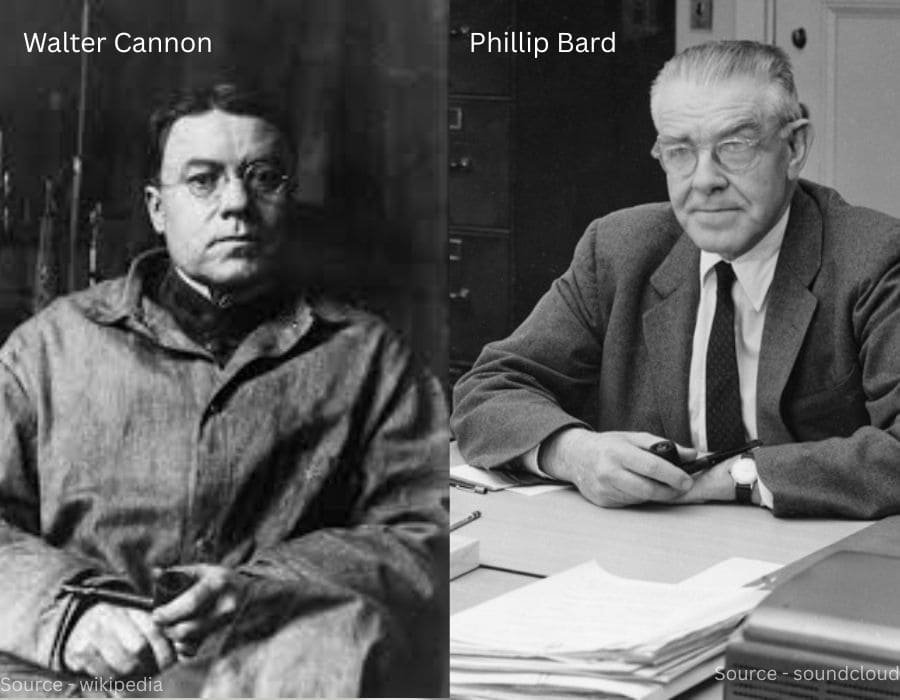Have you ever thought about how we experience our emotions? In psychology, there is a big debate on emotional response. It is much like the classic chicken or egg (which came first) puzzle. Many psychologists, neurologists have studied whether emotions come first or physiological responses. There are many theories come out of this debate. Where some say we experience emotion as a result of a physiological response or cognitive label. And some say that it occurs simultaneously. Let’s learn a theory in this debate that says emotions and physiological responses are experienced simultaneously.

Cannon-Bard Theory of Emotion
The Cannon-Bard Theory was given by Walter Cannon and Philip Bard in 1927. According to this theory, we experience both the emotions and physiological responses simultaneously while we encounter a situation. For example: If you encounter a threatening situation, you may experience fear (emotion) and a Physiological response (sweating, trembling) synchronously. Considering this as the base, the theory states that the emotion we feel and the physiological response we give are independent of each other.
Theory and Brain Regions
This theory is also known as the thalamic theory of emotion, because the authors of the theory say that when we face a stimulus, our thalamus sends a signal to the amygdala and the autonomic nervous system parallelly.
Thalamus
The thalamus is an egg-shaped structure that lies in the middle region of the brain, which is known as the relay station. Every information from the motor and sensory nerves (except smell) from the body will reach this part of the brain first. Then later the information will be sent to different cerebral cortex areas for further process and interpretation.
Amygdala
The amygdala is an almond-shaped structure located in the temporal lobe, which is responsible for all kinds of emotions. It is involved in activating the fight-or-flight response during stressful situations. When we perceive a threat, the amygdala kicks in and activates our body’s stress response. – Shaheen E. Lakhan, Neurologist.
Autonomic Nervous System
The autonomic nervous system is a network of nerves that lies in the entire body and controls the unconscious processes like breathing, digestion, etc. The autonomic nervous system is divided into the sympathetic and parasympathetic nervous systems. When we encounter a situation, the thalamus sends a signal to the sympathetic nervous system and thus creates the physiological responses we exhibit during any stressful or threatening situation.
The sympathetic nervous system deals with the fight or flight response, whereas the parasympathetic nervous system deals with a calm response. And he believed that both sympathetic and parasympathetic responses cannot occur simultaneously.
Applies to positive emotions
Cannon-Bard theory is not only about experiencing negative emotions it also applies to positive situations. Suppose, for example,
- Situation: You are visiting your friend after so many days.
- Emotion: You may experience positive emotions like excitement, happiness.
- Physiological Response: Rapid heartbeat, happy tears.
James-Lange theory and its contradictions
During Cannon’s time, the most popular theory of emotion was the Lange theory of emotion. According to the James–Lange theory of emotion, when we encounter a stimulus, our body reacts first with physical changes, and then we experience an emotion based on those physical reactions. In other words, they believe emotions are the result of our body’s physiological responses.
Stimulus Physiological
Response Emotion
Experiment done by Cannon
Cannon was not compromised by the idea of James-Lange and decided to test his theory. Cannon worked mostly on studies related to animal physiology. So, he experimented with cats. He severed the afferent nerves in cats so that information related to physiological response may not reach the cerebral area to provide feedback. And he found that cats experienced emotions despite the absence of visceral feedback. He considered this as evidence to prove his theory was wrong and came up with his theory of emotion. He criticised on James-Lange theory after his experiment.
- Emotional response persists without visceral feedback: Cats without sympathetic nerves still experienced normal emotional expressions. This proves his idea that physical response and emotions occur independently.
- A Similar Visceral response occurs while experiencing different emotions: The same physiological responses will be experienced in different emotions, like a rapid heartbeat can be felt during positive emotions like excitement and negative emotions like fear. And this makes it difficult to recognise the emotion based on the physiological responses.
- Viscera are relatively insensitive: Sensory input from visceral organs is limited and often goes unnoticed.
- Visceral responses are too slow: Emotional response occurs faster than visceral feedback allows. So, the possibility of feeling emotion after the physiological response is low.
- Induced visceral changes don’t trigger emotions: As per James’ theory, if a physiological response occurs, emotion should be felt. But injecting adrenaline causes physiological changes, but not specific emotions unless an emotional context is already present.
Conclusion
Many critics argued that the Cannon–Bard theory places too much emphasis on the thalamus while overlooking the involvement of other important parts of the brain in emotional processing. And it also stressed that emotions and physiological responses occur together. But later theories about emotions registered their objection towards this idea. And many turn against his stand that the sympathetic and parasympathetic nervous systems cannot work at the same time. Example: When we are under emotional stress, we may experience contraction of the bladder and rectum, which denotes the simultaneous activation of the sympathetic and parasympathetic nervous systems.
References +
Professional, C. C. M. (2025, March 19). Thalamus. Cleveland Clinic. https://my.clevelandclinic.org/health/body/22652-thalamus
PsyD, A. M. (2023, May 20). The role of the amygdala in human behaviour and emotion. Verywell Mind. https://www.verywellmind.com/the-role-of-the-amygdala-in-human behavior-and-emotion-7499223
Professional, C. C. M. (2025, April 1). Autonomic nervous system. Cleveland Clinic. https://my.clevelandclinic.org/health/body/23273-autonomic-nervous-system
Wikipedia contributors. (2024, April 25). Cannon–Bard theory. Wikipedia. https://en.wikipedia.org/wiki/Cannon%E2%80%93Bard_theory
Simply Psychology. (2023, November 9). Cannon-Bard Theory of Emotion: Definition and Examples. https://www.simplypsychology.org/what-is-the-cannon-bard-theory.html